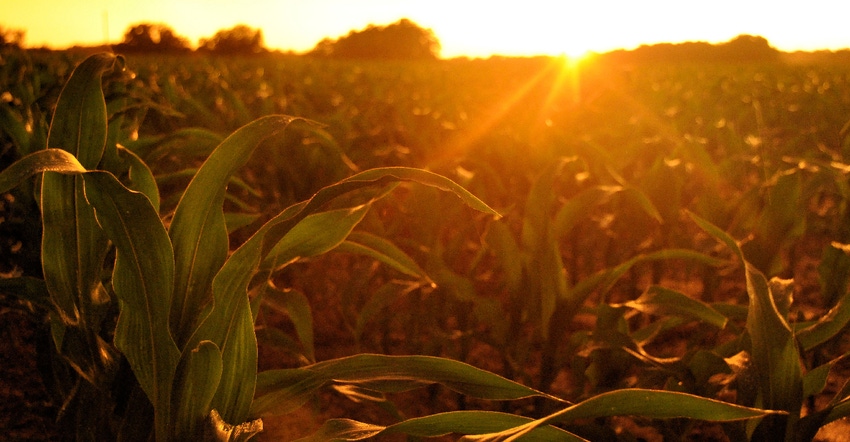January 27, 2021

Our growing season is getting longer. Our nights are getting warmer. Rainfall is both heavy and erratic — and frequent rains are tightening up planting windows.
We know these things to be true. We’re farmers. We see how weather is changing.
Related: Weather the changing storm
But what if these weather changes were actually — please whisper here — good for the Midwest? What if, managed properly, climate change was a net positive here in the Midwest?
I listened to Eric Snodgrass this winter as he raised this very real possibility in a presentation for IL Corn. Snodgrass is principal atmospheric scientist for Nutrien, but before that, he was a University of Illinois atmospheric scientist and a co-founder of Agrible, purchased by Nutrien in 2018.
Related: Tide shifting on climate change discussion
Snodgrass walked through the data: Since the 1950s, temperatures have shifted slightly warmer, but distribution isn’t uniform. In the Northern Hemisphere, this has affected the jet stream, which affects U.S. temperatures. Temps in the Western U.S. have climbed 2.5 degrees over the past 70 years, making the dry season even drier. The rise also creates more dry thunderstorms, featuring rain that struggles to make it to Earth and more lightning that can start more fires. Long term, what does less water mean to agricultural powerhouses like California? Stress, mostly, and concern about long-term productivity.
But back to the Midwest. What do systematic jet stream changes mean for us?
Heat. Crazy-hot summers like 2012 have been less frequent over the past 70 years. They’ll still happen but not as often.
Warm nights. In the Midwest, overnight low temperatures have increased by 2 degrees over the past 70 years.
Humidity. Illinois humidity has increased by 6% since 1970. More moisture in the atmosphere can impact the overnight low temperatures by keeping them higher.
Rainfall. Illinois has seen a statistically significant change in rainfall patterns over the past 70 years. There are more frequent big events during the growing season, followed by longer dry spells. On average, from April to October, the Corn Belt is getting an extra 5.5 inches of rain. In Illinois, the frequency of a 2-inch rain has doubled since 1980; in Iowa, it’s tripled.
Season length. Illinois has seen a 10- to 20-day increase in the frost-free season length over the last 40 years.
Farmers generally have one question at this point: How will this affect our ability to grow crops? For the most part, the answer is good.
Rain makes grain
Snodgrass says data is showing temperature changes will increase productivity in the I-states. More frost-free days, mostly in April, are having a net positive affect. More rainfall? Even better.
“You increase the growing season and add rain, and you can expect productivity to increase,” he says. “We’re able to be more productive because the weather’s letting us do it.”
The catch — and you knew there’d be a catch — is that “increasing variability in precipitation” means it’s gonna rain in the spring when you don’t want it to. Snodgrass’s data shows that the April and May planting window in Illinois has lost five days since the 1980s. If it feels like it’s harder to get your crop in than it was for your dad, you’re not wrong.
Chances are, though, you’ve modified your equipment lineup to plant more faster — like the second planter our family added in May 2019.
We all remember that spring. From June 3 to 10 that year, Illinois farmers took corn acres from 45% planted to 73%, and soybean acres from 21% planted to 49%. Snodgrass claims the year before, in May 2018, the weather broke and Illinois farmers planted 400 acres per minute. Talk about capacity.
But water
So we’re managing the shorter planting window with equipment and technology. But what about extra in-season rainfall? Snodgrass says the overall net effect is that it’s beneficial in Illinois because we have soil that can handle heavy rainfall. But we have to manage it. Pattern tile will move excess rain, but smart farmers will figure out how to retain and manage that water for when they need it.
About 15 years ago, I did a story with a Macomb, Ill., farmer who had installed an experimental controlled drainage system that allowed him to drain water from a field, hold it in a pond, then push it back out through tile lines into the field when crops needed moisture. Smart. Similarly, Snodgrass describes a saturated buffer he saw installed in a field next to the Embarras River; the farmer stored water in his buffer, but could open it and let water trickle back into the field. The system cost him $10,000, but you can bet his yield more than made up for it.
The upshot: We’ve got wetter weather in our future, narrower planting windows, longer seasons, more humidity and warmer nights. If you get the crop in the ground, your chances for a good crop are better than average. Drainage will pay. Managed drainage will pay even more.
Could climate change actually be a net positive for Midwest agriculture? The folks in the know say yes — especially if you manage it well.
Comments? Email [email protected].
You May Also Like




